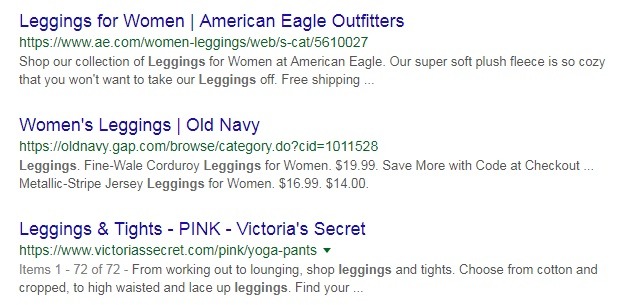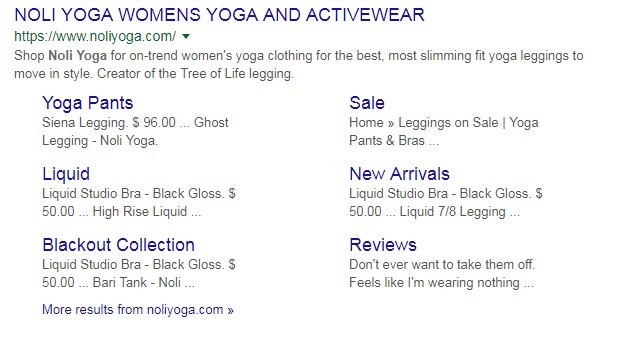Want to know how to write meta descriptions that win? We’ve got the inside scoop!
When it comes to SEO optimization, meta descriptions are key to driving more eCommerce traffic and conversions. Well-written meta descriptions should appeal to more to potential shoppers than bots, therefore improving chances of impressions, clicks and ultimately – sales.
Additionally, a meta description for a product page, your site or site content is often the biggest deciding factor on whether your potential shopper will click through to the page. This means that a strategy of keyword stuffing will do more damage to your eCommerce traffic than good; you need a more thoughtful, holistic approach. An approach designed to get more clicks, drive more traffic and convert more potential shoppers.
Your meta description needs to be relevant to your title, your keywords, the URL and page content, while being clear and compelling. To do that, you want it to be eye-catching and well-presented with good CTAs on SERPs to potential shoppers, drawing in a customer and improving your CTRs.
Plus, good CTRs and good browse-time on your site will result in better rankings overall. In short, meta descriptions count in a big way with regards to your eCommerce traffic and conversion strategy.
In this post, we will look at the how and where of writing meta descriptions that drive eCommerce traffic and conversions.
Step 1: Focus Your Meta Description Efforts in the Right Places
There are four key places you need to put your meta description efforts to help you drive that juicy eCommerce traffic: your store’s homepage, product category pages, product pages and high-traffic content pages.
1. eCommerce Homepage Meta Descriptions
One of your most important meta descriptions is your homepage description. This is the first impression of your brand a potential shopper will have; should include a punchy description of your store and a good reason for them to click through to find out more. Here’s a good example from one of our awesome merchants, Ickle Bubba.
As you can see in this example, they clearly outline what their eCommerce brand is, the pain points their products answer and talk to the needs of their ideal potential shopper.
2. eCommerce Category Page Meta Descriptions
The next meta descriptions you want to review and revamp are your category page meta descriptions. Category pages should include the products you’re selling and the pain points they answer (things, price points or variety) while being written in your target audience’s language. Take a look at these legging product category descriptions; which ones do you think a customer is more likely to click – Old Navy, Victoria’s Secret or American Eagle?
The short answer is, American Eagle and Victoria’s Secret. Why? Because they outline their range and benefits, appealing to their target shopper in a clear and creative way.
3. eCommerce Product Page Meta Descriptions
The same approach discussed above should be used to make your product pages eCommerce traffic-driving superstars! Since they give you an opportunity to discuss specific benefits, they are often easier to create. Here are some great examples of well-written and thorough product descriptions from our top-selling merchant GearBunch:
Not only are these descriptions an excellent example of some awesome copywriting, but their rating, price and stock status extension (or rich snippets – which we’ll discuss below) make them well-structured and click-worthy.
4. High-Traffic Content Meta Descriptions
The final item on your must-have list of well-crafted meta descriptions are your content pages; these are your how-to guides, blog posts and video content. You want to start with content that is generating the most traffic, ensuring you are getting the best CTRs for your efforts. Continuing with our leggings product example, here are some examples of good meta descriptions for yoga leggings blog content:
Now let’s take a closer look at tips on creating well-written meta descriptions.
Step 2: Consider Your Keywords
Before crafting your descriptions, you want to consider your main keywords for your home, category, product and content pages. The keywords will ensure your listings are visible, while your description will ensure people are inclined to click your listing. The trick, though, is balance.
You want to include keywords that are relevant to both what a potential shopper is looking for and the content on the URL you will direct them to. You also don’t want to go keyword-crazy, because even though this may initially bring more search results, excessive keyword stuffing won’t get you the clicks you want for those results.
Instead, choose your relevant keyword focus for each product/category/page, and incorporate them into a well-thought-out description aimed at humans, not bots.
Beginner’s Tip: Visit our beginner’s guides on How to Find the Right Keywords and Popular Keywords for Your Industry.
Step 3: Writing Compelling Meta Descriptions
Next, it’s time to build your traffic-driving meta descriptions. The key to a good meta description can be broken down into two tips:
1. Focus on Creativity, Not Character Count
Although you currently have 155 characters – little more than a tweet’s worth – to creatively get your point across, it’s important to worry less about the count and more about the copywriting. For two reasons:
Character limit suggestions change. In 2017, Google suggested 320 characters and in 2018, they cut it down to 150. Therefore, the ‘ideal’ character length is dynamic and can change at any time. Although you need to be aware of limits, you can play with them. You can play with character limits to create suspense for audiences to want to read more, specifically in terms of blog content. Here’s an example of what I mean:
2. Focus on Your Customers
Most importantly, you need to focus on your customers. Speak your customers’ language, stick to your brand tone and voice, and tell them how your products, categories or posts can help solve specific issues they have. Try using verbs such as ‘shop’ or ‘get,’ build meta description templates for your product pages based on the most successful and click-worthy descriptions, and above all, be accurate. Using clickbait text that is irrelevant to your page or products will only harm your eCommerce brand.
Step 4: Add a Compelling CTA
Where possible and relevant, including a compelling CTA can help you drive those clicks. Careful though – you don’t want to pack a host of over-used CTAs into your 155 character limit, as this will come off as spam and diminish trust. This doesn’t mean just putting ‘Shop Now!’ in all your descriptions; it means playing around with creative CTA copy within your descriptions. Here are two good examples for Bleacher Creature and beard grooming subscription products:
Step 5: Optimize for Featured Snippets
Lastly, you want to optimize for featured snippets. Featured snippets include lists or tables, and can be particularly helpful for eliciting clicks for your home page meta descriptions as well as your blog content and how-to guides.
Snippets are automatically generated based on your pages’ content, through rich results (reviews, events, etc.) and your meta description tags.
- With regards to rich results, you want to add markup to your pages to enable rich product results lets you attract potential buyers. You can read more about it here.
- In terms of homepage snippets, such as the Noli Yoga example above, you need to ensure your home and other pages are indexed correctly.
- When it comes to meta tags, you will need to ensure your content follows Google’s guidelines and is highly relevant, well-crafted and complete.
—
There you have it: how to write meta descriptions that drive eCommerce traffic and conversions. Additionally, it goes without saying that you want to make sure your descriptions are also free of spelling, format and grammar mistakes. Mistakes will diminish trust for your brand and therefore negatively affect your clicks.
Have questions? Post them in the comments below!

Nicole is a content writer with over sixteen years experience and flair for storytelling. She runs on a healthy dose of caffeine and enthusiasm. When she's not researching the next content trend or creating business content strategies, she's an avid beachgoer, coffee shop junkie and hangs out on LinkedIn.
Recommended articles
 Facebook Ads for eCommerce: 16 Strategies, Examples & Tips
Facebook Ads for eCommerce: 16 Strategies, Examples & Tips
 How to Build a Winning eCommerce Ads Strategy
How to Build a Winning eCommerce Ads Strategy
 Google Ads for eCommerce: Everything You Need to Know
Google Ads for eCommerce: Everything You Need to Know
 10X Your Traffic with PPC Management Software
10X Your Traffic with PPC Management Software
Comments
Powered by Facebook Comments













